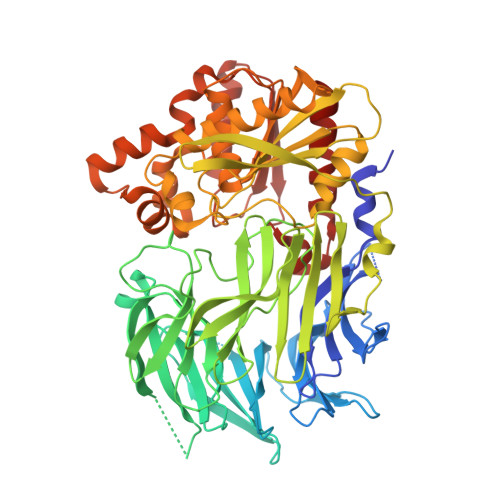Carboxypeptidase in prolyl oligopeptidase family: Unique enzyme activation and substrate-screening mechanisms.
Yadav, P., Goyal, V.D., Gaur, N.K., Kumar, A., Gokhale, S.M., Jamdar, S.N., Makde, R.D.(2019) J Biol Chem 294: 89-100
- PubMed: 30409909
- DOI: https://doi.org/10.1074/jbc.RA118.004254
- Primary Citation of Related Structures:
5YZM, 5YZN, 5YZO, 6IGP, 6IGQ, 6IGR, 6IKG - PubMed Abstract:
Serine peptidases of the prolyl oligopeptidase (POP) family are of substantial therapeutic importance because of their involvement in diseases such as diabetes, cancer, neurological diseases, and autoimmune disorders. Proper annotation and knowledge of substrate specificity mechanisms in this family are highly valuable. Although endopeptidase, dipeptidyl peptidase, tripeptidyl peptidase, and acylaminoacyl peptidase activities have been reported previously, here we report the first instance of carboxypeptidase activity in a POP family member. We determined the crystal structures of this carboxypeptidase, an S9C subfamily member from Deinococcus radiodurans , in its active and inactive states at 2.3-Å resolution, providing an unprecedented view of assembly and disassembly of the active site mediated by an arginine residue. We observed that this residue is poised to bind substrate in the active structure and disrupts the catalytic triad in the inactive structure. The assembly of the active site is accompanied by the ordering of gating loops, which reduces the effective size of the oligomeric pore. This prevents the entry of larger peptides and constitutes a novel mechanism for substrate screening. Furthermore, we observed structural adaptations that enable its carboxypeptidase activity, with a unique loop and two arginine residues in the active site cavity orienting the peptide substrate for catalysis. Using these structural features, we identified homologs of this enzyme in the POP family and confirmed the presence of carboxypeptidase activity in one of them. In conclusion, we have identified a new type within POP enzymes that exhibits not only unique activity but also a novel substrate-screening mechanism.
Organizational Affiliation:
High Pressure and Synchrotron Radiation Physics Division, Bhabha Atomic Research Centre, Trombay, Mumbai, Maharashtra 400085, India; School of Biochemistry, Devi Ahilya University, Indore 452001, India.















